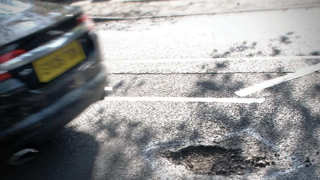Two councils took more than 18 months to repair a pothole, new figures suggest.
The data, obtained by the Liberal Democrats through Freedom of Information requests, has revealed that, while some councils in England are taking more than a month, on average, to fix a pothole once they have been reported, some have been left for 18 months before being repaired.
The Liberal Democrats have criticised the Government for creating a pothole postcode lottery by cutting local authority’s highways maintenance budgets by £500 million (28%) since 2020-21 and announcing a £200m top-up to the national ‘Potholes Fund’ in the Budget last month.
The party is calling for these cuts to roads funding to be fully reversed.
Figures provided by 81 councils show the scale of lengthy pothole repair times across the country.
It took Stoke-on-Trent City Council 567 days to fix an individual pothole after it was first reported, while in London, Westminster City Council took 556 days for one repair.
In total, the 81 councils reported 556,658 potholes in the financial year 2021/22, up from 519,968 in 2017/18.
Roads maintained by Derbyshire County Council were the worst affected with 90,596 potholes, followed closely by Lancashire County Council with 67,439 and Northumberland County Council with 51,703.
Last year, it took Newham Council 56 days on average to repair the 138 potholes reported. Similarly, Lambeth Council took 50 days on average to fix their 462 potholes – five weeks longer than their 2017/18 average of 14 days.
Liberal Democrat local government spokesperson Helen Morgan said: “Motorists should not have to spend their journeys choosing between hitting potholes or dangerously swerving around an obstacle course of tarmac craters.
“People are paying huge bills to repair damage from potholes, while this Conservative Government takes away the money local councils need to repair our roads.
“It is not fair for local residents in some areas of the country to be waiting over a year for road repairs because their council cannot afford it.”
Nearly half of windscreen damage caused by potholes
Separate research from Autoglass found that 44% of drivers in the UK, who have found a chip or a crack in their windscreen in the past 12 months, believe potholes are to blame.
Autoglass found that a third of UK drivers (33%) have had windscreen damage in the past 12 months.
In addition to those blaming potholes, 35% of drivers blamed loose stones or debris on the road and 20% of drivers said damage was caused by bad weather, such as hailstones, flying branches or other debris in high winds.
Ed Colley, head of marketing at Autoglass, said: “The state of the UK roads is clearly having a damaging effect on cars across the UK, and storms and bad weather are increasing the danger of both chips and potholes.
“Chips and cracks can be caused by loose gravel within or the impact of driving over a pothole, and if safe to do so, drivers should avoid them, especially if there is an existing chip in their windscreen.”
Red Corporate Driver Training adds pothole advice to courses
Due to the high levels of damage and disruption fleets are now encountering with potholes, Red Corporate Driver Training has added pothole-specific instruction to nearly all its courses.
With wet weather at the start of the year causing more potholes to appear, councils are struggling to keep on top of road repairs.
As a result, more and more drivers are encountering potholes – causing damage to vehicles, huge disruption and cost to business operations while also posing a safety risk to road users.
Seb Goldin, CEO of Red Corporate Driver Training, said: “It seems remarkable that we should have to do this in 2023, but the fact is pothole damage and disruption is now at epidemic proportions.
“For many businesses it is the main cause of unplanned repairs and downtime, and so we have acted accordingly and added a module to nearly all our courses on how to avoid them, and what to do if you hit one.
“With such a backlog of road repairs, this issue isn’t going away anytime soon, so training and knowledge is the best course of action to help businesses and their drivers solve the problem.”
Red Corporate Driver Training has produced a pothole policy document to share with drivers, which includes:
- Scan the road ahead - usually we urge drivers to look as far ahead as possible, but for potholes you need to keep an eye on the road surface immediately ahead. For the first time, we’re saying ‘eyes down’ rather than ‘eyes up’.
- Have a plan – if you can get around a pothole, do so and indicate your intention so following cars are alerted to the issue. If the road isn’t clear to overtake, slow down to avoid hitting the pothole at speed.
- Educate your drivers – if a local road is a known pothole blackspot, instruct your drivers to avoid the road at all costs.
- If the worst happens and you hit a pothole, find a safe place to stop and inspect your vehicle. Check for bulges in the sidewall of the tyre, which could indicate damage to the carcass. If there is damage to the tyre or vehicle, DO NOT attempt to fix the car at the roadside – call a roadside recovery company who will get you to safety.
- Finally, report the pothole location at www.gov.uk/report-pothole. If the local authority is unaware of the pothole, it can’t fix it.
Goldin added: “Pothole damage and disruption is such an important issue, and it’s not being addressed, so fleets need a strategy to minimise its impact.
“It’s not just as simple as telling drivers to avoid them – there are so many, and they appear so randomly that it requires training on how to identify them, as often they are hidden under water or at the roadside.
“Also, sometimes a driver has little choice about hitting one and so there are strategies around how to make good decisions about avoidance and minimising the impact, and also what to do after you’ve hit one.
“So it made sense to add it to most of our courses, as it could ultimately save your company hundreds, if not thousands, of pounds in repairs and downtime to vehicles.”























Login to comment
Comments
No comments have been made yet.